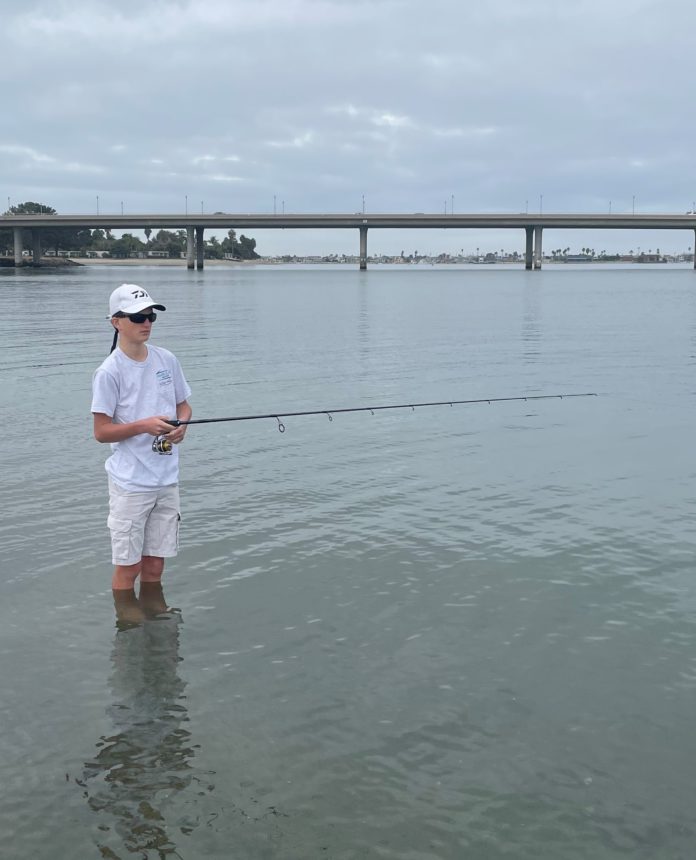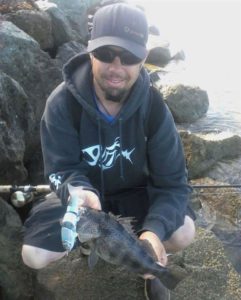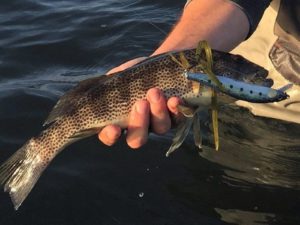
BY CAPTAIN BILL SCHAEFER
We all have fond fishing memories growing up. One fishing experience I have done for most of my life is just a relaxing day of walking the shoreline of the southern California bays and catching a few spotted bay bass. There are always the incidental catches of corbina, sargo, and maybe a bonus keeper halibut. There can even be some small game fish like bonito and barracuda and the rare bonefish or corvina. Now, I know that it can be frustrating at times, because all you keep catching is weeds. But, I hope to help you with that and make it more fun.
So, if the tides are right, and by that, I like to fish through a high tide. It puts a little more water over the shoreline weeds and the limited area you can cast to. Usually with a high tide, the fish do venture up tight to look for clams and crustaceans. Halibut will actually venture into the shallowest water, the sandy inside of the weedline that surrounds most bays. But, if you’re just out and about and want to take some casts, don’t worry so much about the tide and just relax and enjoy your day. If the tide is moving, you have a chance of catching something.

Let’s talk first about if the tide is out and the weeds are right off the bank. Now, you can fish with waders or just wade into the water up to your waist with swim trunks. Maybe wear diver’s booties or old tennis shoes like I do. This will give you optimum casting distance out beyond the thicker shore area weeds and into prime fish spots. I often look for, and most of my favorite areas to fish from shore, are a steeper bank dropping off into deeper water. I feel there’s more fish along a shoreline like this. Rocky, rip-rap shores can also be an advantage and a way to access deeper water. They tend to drop off quicker than natural tapered sandy beaches.
For tackle, I used to actually keep a two piece spinning rod and reel in the back of my truck along with a box of bay baits. This was when I lived a block from one of the bays in San Diego. I would often be driving along and see breaking fish and run down to the shore and score either some small barracuda or bonito. Spoons are something to always have in your shoreline bag. I run a Daiwa Tatula spinning set up now with 20 pound braid (about the diameter of 4 to 6 pound mono) and a 15 pound fluorocarbon leader. You can catch almost anything with this setup. Also, I would have a quick clip tied on to change weight quickly or from jighead to spoons.
For baits, I like to keep the weight down on my jigheads. Some anglers will want to throw a heavy weight to get out further, but this can often lead to dredging up weeds when shore fishing. A small swimbait or grub on a 1/8th to ¼ ounce jighead will work. A Gary Garland type Gitzit tube bait can have a packing peanut shoved into it to make it sink slower and give it more neutral buoyancy. You can also do a freshwater drop-shot type set up. I will usually go a little longer with my tag end to the weight when using this setup in the bay. The weight drags the bottom, pulling easily through weeds, and the swimbait or grub stays up out of the weeds and in the fish zone.
For areas where the weeds are way off the shoreline, then you can swim other baits over the weeds to attract strikes. Lighter weight spinnerbaits can be run over the weedy bottom. You may just have to reel a little faster and raise you rod tip once you get closer to shore. A few casts with it will let you gauge how long to let it sink and retrieve before you have to worry about weeds. Crankbaits can also be used from shore. The trick is to use a floating one and crank it down and start to walk it back. That is, to lessen the cranks between pauses and lengthen the pauses as you get back closer to shore. The floating up usually attracts the bite and you will get the rhythm down after a few casts. Jerkbaits with or without longer lips can do well also.
When the water is a little higher, or the weeds run way out, I like to use fluke style baits. They can be run with no weight and just the weight of the hooks takes them down to the weeds, but not into them. A small twitch of your rod’s tip sends the bait into a slow spiral that attracts the bass and halibut. A grub, rigged on a wide gap hook, weedless, will also do well with its fluttering fall. The bass sit in the weeds and wait for their meal to come by and charge it.
Weightless Yamamoto Senkos and Kreature baits, manufactured with a lot of salt in them will sink slowly with just the weight of the hook and all that salt. They become kind of neutral buoyant and will not sink down into the weeds, resting on top of them. Twitching these along the tops of the eel grass will also draw strikes. I usually stay down in size to let the spottys, with their smaller mouths, grab onto them and suck them in. Any crab or crawdad type bait will do fine. The baits do not necessarily have to have flutter. You can create the action with your rod tip.
Another trick we used to use were the use of the old clear trout bubbles. I’m sure you have all used them before when trout fishing. If not, they are a clear plastic bubble that you can fill with water, making it a weight that you can throw a mile, but because you only fill it, say ¾ full of water, it sinks slowly and doesn’t plow down into the eel grass. It should just rest on the top. That is the point of it. You rig it like a Carolina rig; main line run through it and tied to a swivel; then a leader and hook appropriate to the bait you want to throw. I usually went with a small chartreuse grub most of the time. This setup lets the bait flutter on top of the eel grass for strikes.
If the water is high enough that there is plenty of water to the inside of the weed band around the bays, then the bass and halibut will often venture into the sandy side of the weeds. Since you’re only fishing about 1 to 4 foot of water you can use almost anything since there’s no weeds or very little. I will often throw a jerkbait in chrome with a black or blue back to emulate an anchovy. You will be surprised how well this works. How often do you see fish chasing bait in the shallow water? It should be a floater so it rises on the pause. Mixing up your retrieves on almost any bait can and will produce strikes.

So, let’s review shore fishing the bay real quickly one last time. Any time fishing the shore can be fun. Tides don’t have to play a factor, but if you can adjust to them it can help make a difference. Or, if you just need to, you just go fishing. Whether you fish from sand or rocks is up to you. Fishing from docks is another article to come. Fishing from shore is a way to enjoy a day with the kids and family and hopefully catch some fish. Many times there are parks next to the water where you make a day or it, barbeque and have family time.
Some of these tricks should help you have fun and make it a successful day. Set yourself up a small tackle box/bag/backpack and keep it in the car with a casting or spinning rod, which ever you like more. Maybe some old beach towels to dry off with in case you go wading. After a while, you’ll know what you need to bring. You never know when you may have some time to kill during the day. You might as well enjoy it along the shoreline of the bay. And, catch some fish in the process.



